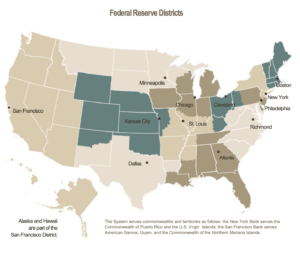Agriculture Secretary Brooke Rollins said on Tuesday that the Trump administration will announce a 'bridge payment' for farmers next week that is designed to provide short-term relief while longer trade…
Federal Reserve: Observations on the Ag Economy- August 2023
On Wednesday, the Federal Reserve Board released its August 2023 Beige Book update, a summary of commentary on current economic conditions by Federal Reserve District. The report included several observations pertaining to the U.S. agricultural economy.

* Sixth District- Atlanta– “Agricultural conditions were little changed since the previous report. Demand for cattle was strong. Egg supply increased, but the supply of hens remained lower than normal. The supply of chickens continued to exceed demand, although there was some improvement in the market. There continued to be excess supply of milk in the market. Many row crops were expected to have a strong harvest. Demand for cotton remained weak, leading some growers to exit the cotton market.”
* Seventh District- Chicago–
District farm income expectations for 2023 remained much lower than 2022 levels. However, reduced costs for some inputs, particularly fertilizers, boosted net income prospects for 2024.
“Drought concerns lessened overall, although hot weather toward the end of the period impaired development of a wide swath of Midwest crops. Corn, soybean, and wheat prices were down. Still, there were reports of a slowdown in exports as prices offered by other producers were more favorable on world markets. Hog prices moved down after hitting a seasonal peak. Prices for dairy products rose from low levels, and egg prices crept up a bit. Cattle prices increased once again, remaining one of the few agricultural prices above the levels of a year ago. Farmland prices were still higher than a year ago.”
* Eighth District- St. Louis– “District agricultural conditions have been mixed since our previous report. Despite record-breaking heat and heat- dome-induced thunderstorms across the District, the percent of cotton and rice rated fair or better stayed stable throughout the reporting period, with cotton returning to 2021 rating levels after a moderate dip in 2022.
Corn and soybean ratings both decreased more significantly during the summer months, sustaining their fall below 2020-2021 levels the previous year.
“District contacts described feeling the effects of extreme weather and increased interest rates in the form of higher input costs. On net, contacts indicated a slight decline in dollar value sales and an increase in inventories.”
* Ninth District- Minneapolis– “District agricultural conditions weakened slightly. More than a third of respondents to a survey of agricultural credit conditions reported that farm incomes decreased in the second quarter from a year earlier. Several contacts noted that while commodity prices were still favorable, they were retreating to levels that could be below break-even for some producers given high input costs. Drought conditions improved recently but remained a concern, especially in eastern portions of the region.”
* Tenth District- Kansas City– “The farm economy in the Tenth District remained strong, but conditions softened alongside lower agricultural commodity prices and persistent drought. Volatility in markets for major crops was elevated amid heightened uncertainty about supply and demand conditions. Through mid-August, prices for corn and wheat were about 10% lower than the beginning of the month and soybean prices also dropped slightly. In the livestock sector, cattle prices remained strong and continued to support profit opportunities, despite considerable cost pressures. Large areas of the region continued to be heavily impacted by drought that could reduce crop revenues and limit availability of feed for livestock operations.
District contacts continued to highlight input costs, interest rates and thinner margins as other key concerns. Lenders indicated that credit conditions remained sound with support from strong farm finances.
* Eleventh District- Dallas– “A significant portion of the district entered (or reentered) drought over the past six weeks due to meager rainfall and soaring temperatures. Pasture conditions deteriorated, and the weather had an adverse effect on row crops. A majority of the Texas cotton crop was rated in poor to very poor condition, and abandonment is expected to be high this year. Cattle prices rose further over the reporting period, driven by tight supply and solid demand for beef.”
* Twelfth District- San Francisco– “Conditions in the agriculture and resource-related sectors remained largely unchanged during the reporting period. Domestic retail and food services demand for agricultural products was stable, with strength noted particularly for fruits and vegetables. A contact from Arizona reported challenges with limited availability of produce for retail outlets. Exports of some products, such as grain and hay, reportedly fell, resulting in increased domestic supply levels and lower domestic prices. Major fish stocks were stable. Though yields for some crops remained low due to the wet winter, contacts reported high volumes of crops carried over from the prior harvest and strong projections for this year’s perennial crop yields in California and Washington. Production input costs remained elevated with upward movement for some costs, such as packaging and energy.”





